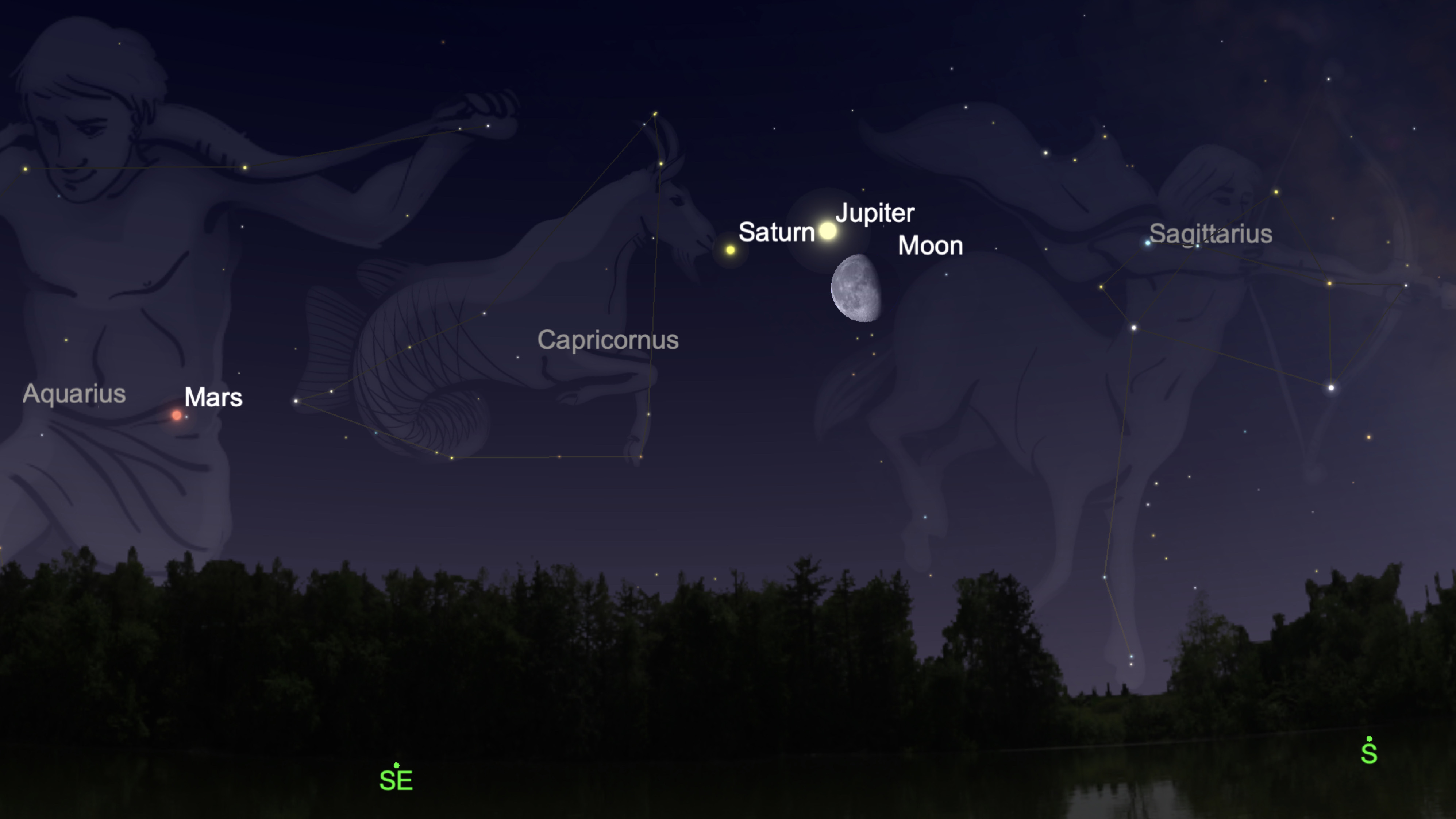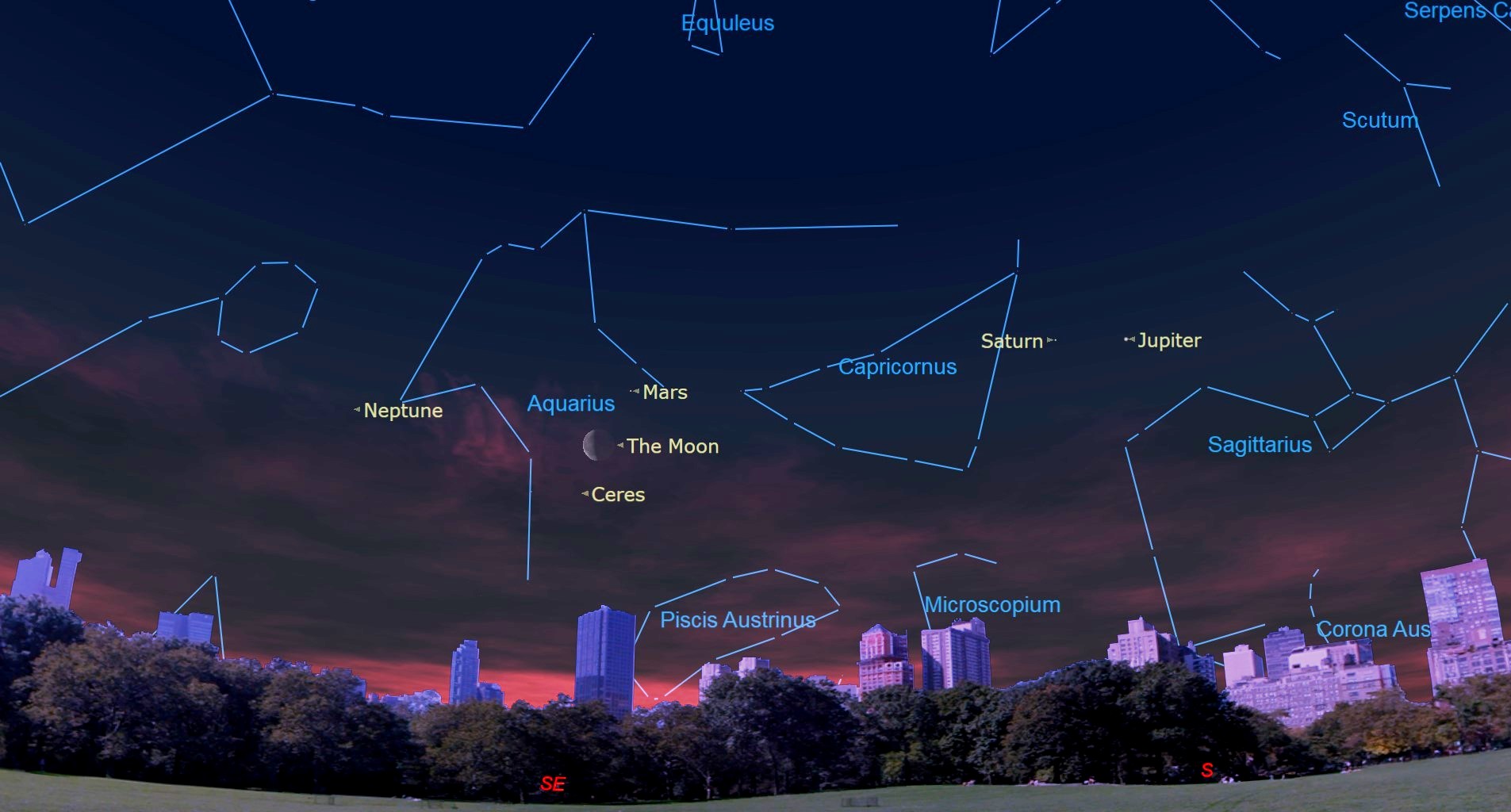See the moon near Jupiter and Saturn in the predawn sky Tuesday
Early-bird skywatchers have a chance to can see the moon swing by two bright planets in the predawn sky on Tuesday (May 12).
The waning, gibbous moon will meet up with the planets Jupiter and Saturn, and you can catch the celestial trio above the southern horizon just before they fade into the daylight.
Over the course of the next few days, the moon will scoot eastward in the morning sky. On Tuesday, it will be in the constellation of Sagittarius (the archer), along with Jupiter. By Wednesday, it will be in the constellation Capricornus (the sea goat), where Saturn is currently located, and by Friday morning the moon will be snuggling up to Mars in the constellation Aquarius (the water bearer).
Related: The brightest planets in May's night sky: How to see them
Jupiter will be in conjunction with the moon, meaning they share the same celestial longitude, on Tuesday at 5:41 a.m. EDT (0941 GMT) — at the exact time that the sun will rise over New York City, according to the skywatching website In-The-Sky.org. The moon will be 2.25 degrees to the south of Jupiter at that time. (For reference, your clenched fist held at arm's length measures about 10 degrees wide.)
Saturn will also be in conjunction with the moon that same day, but not until 2:11 p.m. EDT (1811 GMT), when daylight will hamper the view of the ringed planet. Although Saturn will not be visible at the time of its closest approach, it will appear almost as close to the moon on the morning of the encounter. When they are at their closest, the moon will be 2.6 degrees to the south of Saturn.
If you're more of a night owl than a morning person, you can also catch the trio together after midnight. For example, Jupiter rises over New York City at 12:44 a.m. local time on Tuesday (May 12), followed by Saturn 16 minutes later, according to timeanddate.com. Jupiter sets again at 5:30 a.m., followed by Saturn at 5:50 a.m. local time. The moon rises over New York City at 12:48 a.m. and sets again at 10:15 a.m. local time.
Breaking space news, the latest updates on rocket launches, skywatching events and more!
Mars is also visible in the morning sky this week, and it will have its own close encounter with the moon on Thursday night. The Red Planet will be in conjunction with the moon on Thursday (May 14) at 10:02 p.m. EDT (0202 GMT on May 15). It will rise that morning over New York City at 2:18 a.m. local time and will still be in the sky by the time dawn breaks.
Editor's note: If you have an amazing night sky photo you'd like to share for a possible story or image gallery, you can send images and comments to spacephotos@space.com.
- When, where and how to see the planets in the 2020 night sky
- Saturn, Mars and Jupiter align over NYC in gorgeous night-sky photos
- See the Full Flower Moon, last supermoon of 2020, bloom in these stunning photos
Email Hanneke Weitering at hweitering@space.com or follow her @hannekescience. Follow us on Twitter @Spacedotcom and on Facebook.
OFFER: Save 45% on 'All About Space' 'How it Works' and 'All About History'!
For a limited time, you can take out a digital subscription to any of our best-selling science magazines for just $2.38 per month, or 45% off the standard price for the first three months.

Hanneke Weitering is a multimedia journalist in the Pacific Northwest reporting on the future of aviation at FutureFlight.aero and Aviation International News and was previously the Editor for Spaceflight and Astronomy news here at Space.com. As an editor with over 10 years of experience in science journalism she has previously written for Scholastic Classroom Magazines, MedPage Today and The Joint Institute for Computational Sciences at Oak Ridge National Laboratory. After studying physics at the University of Tennessee in her hometown of Knoxville, she earned her graduate degree in Science, Health and Environmental Reporting (SHERP) from New York University. Hanneke joined the Space.com team in 2016 as a staff writer and producer, covering topics including spaceflight and astronomy. She currently lives in Seattle, home of the Space Needle, with her cat and two snakes. In her spare time, Hanneke enjoys exploring the Rocky Mountains, basking in nature and looking for dark skies to gaze at the cosmos.



